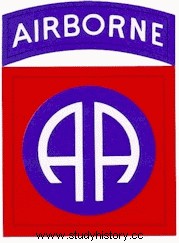
The 82nd US Airborne Division - 82nd Airborne Division - is a parachute division of the United States Army. She distinguished herself during the Normandy landings, she also participated in Operation Market Garden and the Battle of the Ardennes. In 2003, she took part in the conquest of Iraq.
The First World War
Originally, it was an infantry division. The 82nd Infantry Division - 82nd Infantry Division - was formed in August 1917 at Camp Gordon (Georgia), with men from all states, hence the nickname "All-Americans". She entered the campaign in France in 1918 where she had 1,298 killed in action and 6,248 wounded. It was dissolved after the war.
The Second World War
On March 25, 1942, the unit was reconstituted in Louisiana as an infantry division under the command of Omar Bradley. In August 1942, the latter, designated for another function, was replaced by Brigadier General Matthew B. Ridgway. The division is reorganized and becomes the first American airborne division. On August 15, it took the name of 82nd Airborne Division. In October 42, she moved to Fort Bragg (North Carolina). It is still attached today to the XVIII American Airborne Corps.
North Africa
In May 1943, the division landed in Casablanca (Morocco) and joined Tunisia.
Italy
On July 9, 1943, the 505th regiment of the division, under the command of Colonel Gavin, and the 11th, the 504th parachuted near Gela as part of Operation Husky (landing in Sicily).
In September 1943, 2,500 men from the division, under the command of Colonel Gavin, jumped at night into the Gulf of Salerno as part of Operation Avalanche.
On October 1, 43, the division entered Naples.
Battle of Normandy
In April 44, the division was transported to England for Operation Overlord. It was then made up of the 505th, 507th and 508th parachute infantry regiments (Parachute Infantry Regiment) - as well as the 504th which was being reconstituted after its losses in Italy - 325th airborne regiments (Glider Infantry Regiment), three artillery battalions of campaign and an anti-aircraft artillery battalion.
With the 101st Airborne Division, it jumps on the western flank of the landing zone. A detachment of the unit seized Sainte-Mère-Eglise on the night of June 5 to 6, 1944.
The scouts (pathfinders) of the 82nd and 101st airborne divisions, equipped with radio beacons and means of communication, had left RAF North Witham on the evening of June 5, 1944, to mark out the areas over which the bulk of the troops were to jump.
Operation Market Garden
In September 1944, under the command of young General James M. Gavin (37) nicknamed "jumping Jim", the division took part in Operation Market Garden, the largest airborne operation of the war. Its mission is to seize the bridges of Grave and Nijmegen.
Battle of the Bulge
* From December 16, 1944 to the end of January 1945:In reserve in the Reims region, the division is directed towards the Belgian Ardennes and engaged in the Stavelot region. She participated in the battles of La Gleize and Stoumont.
1945
In February 1945, she fought in the Ruhr then returned to France for reconstitution.
In April 1945, she was on the Elbe in Germany and operated the junction with the Red Army.
At the beginning of May 1945, it liberated the Neuengamme camp and most of these commandos.
After the armistice, she was sent to Berlin.
During this campaign, she deplored 1,619 killed in action, 6,560 wounded and 332 died of their wounds.
Santo Domingo
In April 1965, the division was engaged in an operation in the Dominican Republic in the throes of a civil war.
Vietnam War
In February 1968, following the Tết offensive, a brigade of the division was sent to Hué.
In 22 months of presence, she had 184 killed and 1,009 wounded in action.
Gulf War (1990-1991)
She participated in this conflict where one of her brigades was attached to the French Daguet division.
War in Iraq
Arriving in the Middle East during the winter of 2003, the 82nd Airborne received the mission of stabilizing the Sunni west of Iraq, in particular the city of Fallujah. It was men from this division who opened fire on a demonstration at the beginning of the summer of 2004, triggering the insurrection in this city which has become the symbol of the Islamist and Baathist insurgency in Iraq.
Relief operations in Louisiana in 2005
Following the disaster caused by Hurricane Katrina, 5,000 paratroopers took part in the rescue. Their center of operations was at New Orleans International Airport.
Structure in 2005 and 2007
Today, the 82nd Airborne Division is one of the components of the XVIII American Airborne Corps. In 2005, it had three combat brigades:
* 1st Brigade / 504th Parachute Infantry Regiment;
* 2nd Brigade / 325th Airborne Infantry Regiment;
* 3rd Brigade / 505th Parachute Infantry Regiment.
According to the US Army reorganization plans, it is organized around four combat brigades and a US Army Aviation brigade in 2007.
Organization chart in 2007
Commanders
Commander:(at creation) Major General Matthew B. Ridgway
Deputy:Brigadier General James M. Gavin (Commander after Normandy) 2nd Deputy:Brigadier General George P. Howell
On the film side, we can remember that Lieutenant-Colonel Benjamin H. Vandervoort of the 2nd Battalion (505th Para Infantry Regiment) was played by John Wayne.
Lieutenant-Colonel H. Vandervoort, injured in his left ankle during his parachute drop, refused to be treated in order to participate in the capture and securing of Sainte-Mère-Eglise:reason why the scriptwriters of The Longest Day made a close-up on this officer and gave the role to the emblematic John Wayne!
